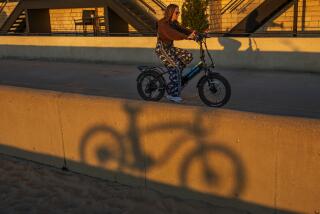GOOD HEALTH MAGAZINE : FITNESS : A MATTER OF SAFETY
- Share via
It’s difficult to establish how safe bicycling is. In 1985, 1,300 people died and another 574,000 were treated in emergency rooms following cycling injuries. Those numbers may sound small compared to the totals of auto fatalities and injuries--more than 45,000 and 3 million respectively during the same period--but there are no figures on the number of bicycle miles traveled per year to serve as a comparison.
Cyclists can do much to protect themselves. Rule No. 1 is never to ride without wearing a helmet approved for bicycle use by either the Snell Foundation or the American National Standards Institute, or both. Head injuries cause or contribute to death in 70% to 80 % of cycling-related fatalities. In a study published in the May 25, 1989 issue of the New England Journal of Medicine, researchers reported that riders wearing helmets “had an 85% reduction in their risk of head injury, and an 88% reduction in their risk of brain injury.”
Children are especially at risk for head injuries from cycling. A Canadian study found that, among children, cycling was the No. 1 cause of head injuries that resulted in hospital admissions. A Swedish study concluded that children younger than 11 or 12 “simply do not have the maturity to handle themselves in anything but the simplest traffic situation.” Also, small children are less able than adults to localize sounds or see out of the corners of their eyes. They have less strength and coordination. Finally, children are more likely to have bicycles that do not fit or are poorly maintained.
All riders should follow basic rules of the road. Statistics from the Insurance Institute for Highway Safety suggest that people who drive like moms and dads, the Ward and June Cleavers of the world, are the least likely to be injured in car accidents: Injury claims are considerably lower for station wagons than for sedans, and lower for sedans than coupes. Undoubtedly, cyclists who ride carefully are less likely to get hurt than hot-doggers.
About 75% of accidents happen at intersections. Cyclists should watch out for oncoming and left-turning cars and should ride well away from buses or other large vehicles that might hide them from oncoming traffic.
The best way to avoid getting snagged by an opening door of a parked car is to ride beyond its reach. Bicycles are rarely hit from behind in slow, daytime urban traffic, so cyclists need not be shy about asserting their right to the road. If someone opens a door on you and there’s no possibility of swerving out of the way, scream at the top of your lungs and hit the brakes. Don’t waste time trying to ring a little bell.
To guard against getting hit from behind, use a rear-view mirror. I have worn mirrors on my spectacles or in my helmet since 1975, and I prefer the Third Eye, a brand that mounts on the helmet. It’s small, but its view is terrific, and you can pan simply by turning your head. Having a rear-view mirror means being able to communicate with the cars behind you: If they are coming too close, I signal them to slow down, by showing the palm of my left hand; or to suggest that they move out into the other lane, with a flick of the wrist.
Apart from careful riding, cyclists can minimize their chance of injury by wearing bright clothing. I wear mostly bright yellow, said to be the most visible common color in daylight. When the temperature is brisk, I wear my phosphorescent-looking lime-green jersey.
The most visible colors by day are not necessarily visible when the sun does down. Red is extremely hard to see after dark. White is the most visible color at night. However, white at night is no substitute for strong headlights and taillights, although it is a good supplement.
When you buy a helmet, make it a brightly colored one, especially if you do a lot of biking at night.






